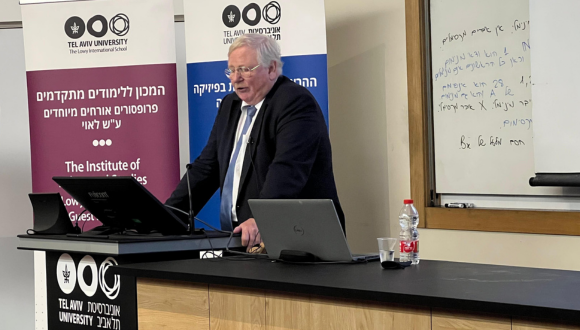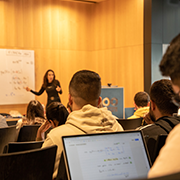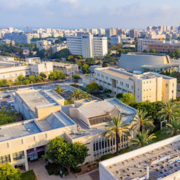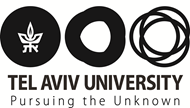Nobel Laureate Reinhard Genzel Visits TAU as a Lowy Distinguished Guest Professor
Unveiling the Universe’s Mysteries
In January, Tel Aviv University (TAU) hosted Nobel Laureate Professor Reinhard Genzel for a lecture on recent advancements in understanding black holes and their role in shaping galaxies, as part of TAU’s annual Ne’eman Physics Colloquium. Genzel visited under the auspices of the Lowy Distinguished Guest Professors framework, made possible by The Lowy International School.
During his visit, Genzel also participated in a podcast discussion with his host and longtime colleague Prof. Amiel Sternberg, from TAU’s School of Physics and Astronomy; the two delved into how Genzel’s research career developed, including what led him to ultimately discover a compact object at the center of the Milky Way and win the 2020 Nobel Prize in Physics.
In the podcast episode, Genzel also details his long history of collaboration with his Israeli colleagues, reflecting, for instance, on a recent three-day symposium in December that brought together top German and Israeli science organizations and universities: “It was fantastic to see how much we appreciate each other,” he said.
Similarly, Genzel began his lecture, Massive Black Holes & Galaxies: Experimental Evidence & Cosmic Evolution, by emphasizing the decades-long connections he has had with Israeli research institutions. “I am absolutely proud, as a German and as a scientist, to have had that companionship,” said Genzel, who was officially representing the Max Planck Society. “In difficult times, I think it’s important to stand by your side.”
The Mystery of Black Holes
The focus of Genzel’s talk was the enigmatic nature of black holes, particularly the supermassive black hole at the heart of the Milky Way Galaxy, called Sagittarius A*. He explained that black holes, first predicted by Einstein’s general relativity, were initially theoretical. However, through years of patient observation and technical innovation, scientists started to gather direct evidence of their existence. “The question was … do they really exist, and can we prove it?” Genzel remarked.
“It’s mind-boggling that three different techniques – observations with high resolution of gas and stars, gravitational waves and also very high-resolution short wavelength radio interferometric observations – have in the last 10-15 years really pushed this topic from pure speculation to scientific truth.”
Genzel highlighted, for instance, the breakthrough observations of stars orbiting Sagittarius A* at incredible speeds, reaching thousands of kilometers per second. These stellar orbits provided compelling evidence of a supermassive object. “We can see [these stars] moving night to night … and how they orbit,” he explained. “That’s incredible … and it gives us very precise information on the mass.”
The Galactic Center and Cosmic Evolution
The lecture also delved into the relationship between black holes and galaxy formation. Genzel discussed how black holes accumulate material and release energy, shaping the environments around them. By studying active galactic nuclei in distant galaxies, researchers have traced the growth of black holes and their co-evolution with their host galaxies, with the ratio of the black hole’s mass to the galaxy’s mass roughly constant.
He also shared intriguing results from gravitational wave astronomy, which has revealed new insights into stellar black holes, which suggest that black holes might grow faster or through additional processes than previously thought. “All of this is on the table right now,” Genzel stated. “Of course, that will be the goal of understanding the story in the next 10 years.”
Future Prospects
Looking ahead, Genzel emphasized the need for more advanced instruments to probe black holes further. He described how future experiments with gravitational waves and next-generation telescopes, for instance, could help resolve some of the field’s most perplexing questions. As part of this, Genzel pointed to the recent discovery of a star orbiting in the vicinity of Sagittarius A*, something which suggests that a black hole’s gravitational force may not be as destructive as previously understood.
Genzel ultimately ended his talk by encouraging the future generation of researchers to take up the mantle, including those attending the colloquium: “Come on, join the crowd,” he told them. “This is exciting stuff.”
Interested in The Lowy Distinguished Guest Professors framework and how it helps to bring eminent scholars to TAU? Learn more here.


![International Collaboration in Theater Studies at the [six!] Summer School in Chicago International Collaboration in Theater Studies at the [six!] Summer School in Chicago](https://international.tau.ac.il/sites/english.register.tau.ac.il/files/styles/research_teaser_image_180_x_180/public/six%20180.png?itok=uJ2RPwUm)


